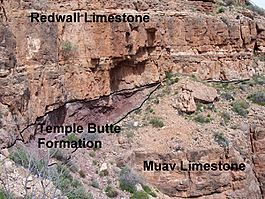Muav Limestone facts for kids
Quick facts for kids Muav LimestoneStratigraphic range: Middle Cambrian 502–499Ma |
|
|---|---|

representative sequence of Redwall Limestone, Temple Butte Formation, and Muav Limestone, in Grand Canyon
|
|
| Type | Geological formation |
| Unit of | Tonto Group |
| Underlies | either the Frenchman Mountain Dolostone (Cambrian) or Redwall Limestone (Mississippian). Locally underlies Temple Butte Formation (Devonian) that fills narrow paleovalleys cut into the Muav Limestone. |
| Overlies | Bright Angel Shale |
| Thickness | 250 m (820 ft), at maximum |
| Lithology | |
| Primary | limestone and dolomite |
| Other | shale and intraformational conglomerate. |
| Location | |
| Region | Northern Arizona (Grand Canyon), central Arizona, southeast California, southern Nevada, and southeast Utah |
| Country | United States of America |
| Type section | |
| Named for | Muav Canyon, north side of Colorado River |
| Named by | Noble (1914) |
The Muav Limestone is a rock layer found in the Grand Canyon and nearby areas. It's part of a larger group of rocks called the Tonto Group. This rock layer formed a very long time ago, during the Cambrian Period, which was about 500 million years ago!
The Muav Limestone is mostly made of limestone and dolomite. These rocks are usually gray and can look a bit mottled, like they have spots or streaks. You might also find thin layers of shale (a soft, layered rock) and conglomerate (rock made of pebbles cemented together) within it.
When you see the Muav Limestone in the Grand Canyon, it often forms cliffs or small ledges. These cliffs can be dark gray or even a rusty-orange color. They sit right on top of another rock layer called the Bright Angel Shale. The thickness of the Muav Limestone changes depending on where you are. For example, it's about 76 m (249 ft) thick in the western Grand Canyon but only 14 m (46 ft) in the eastern part.
Contents
Naming the Muav Limestone
In 1875, a scientist named G. K. Gilbert first mapped the rocks in the lower Grand Canyon. He gave names to the different layers he found.
Later, in 1914, another scientist named L. F. Noble updated these names. He officially named this rock layer the Muav Limestone. He described it as the main limestone part of the Tonto Group.
Where Muav Limestone Meets Other Rocks
The Muav Limestone sits on top of the Bright Angel Shale. In some places, these two rock layers mix together. This means they formed at similar times, with one gradually changing into the other.
Above the Muav Limestone, you might find a rock layer called the Frenchman Mountain Dolostone. This layer sits directly on top of the Muav Limestone in the western Grand Canyon. However, as you go eastward, the Frenchman Mountain Dolostone disappears. In those areas, a much younger rock layer, the Redwall Limestone, sits directly on top of the Muav Limestone.
Sometimes, you can also find a rock called the Temple Butte Formation filling in old valleys that were carved into the Muav Limestone.
Ancient Life: Fossils in Muav Limestone
Fossils are not very common in the Muav Limestone, and they are often hard to see clearly. However, scientists have found some interesting clues about ancient life here.
- Body Fossils: These are the actual remains of creatures. In the Muav Limestone, you might find parts of sponges, brachiopods (shellfish), hyoliths (cone-shaped creatures), and trilobites (ancient sea bugs). The most common body fossils are different types of trilobites.
- Trace Fossils: These are not the creatures themselves, but signs they left behind. In the Muav Limestone, you can find invertebrate burrows and trails. These are like fossilized tunnels or tracks made by worms or other creatures moving through the mud long ago. These traces are why much of the Muav Limestone looks mottled or spotted.
The types of fossils found in the Muav Limestone are similar to those in the Bright Angel Shale below it. This suggests that these two rock layers formed around the same time.
How the Muav Limestone Formed
Scientists believe the Muav Limestone formed in a shallow ocean environment. Over millions of years, the sea level changed many times. The ocean would rise (a transgression) and then fall (a regression).
These changes caused different types of sediment to be laid down. When the sea was deeper, limestone formed. When it was shallower, or when rivers brought in more mud, layers of shale or sand were deposited. This is why the Muav Limestone sometimes mixes with the Bright Angel Shale, showing how the ocean environment shifted back and forth.
Gallery – Muav Limestone
-
Muav Limestone cliff example, below Redwall Limestone cliff, on the North Kaibab Trail (closeup photos, often show purple erosion debris)(expandable photo)
-
(view due-north, northeast, from Bright Angel Trail, (South Rim section) – View of south-draining Bright Angel Canyon, containing in its lowest section with the Tapeats Sandstone, upon the Granite Gorge, the cliffs of gray-brown Muav Limestone (25% at base of Redwall Limestone), laid upon the slope-forming & greenish Bright Angel Shale. (The trail also descends/ascends through units on the South Rim, at near photo view.)
See also
- Geology of the Grand Canyon area




